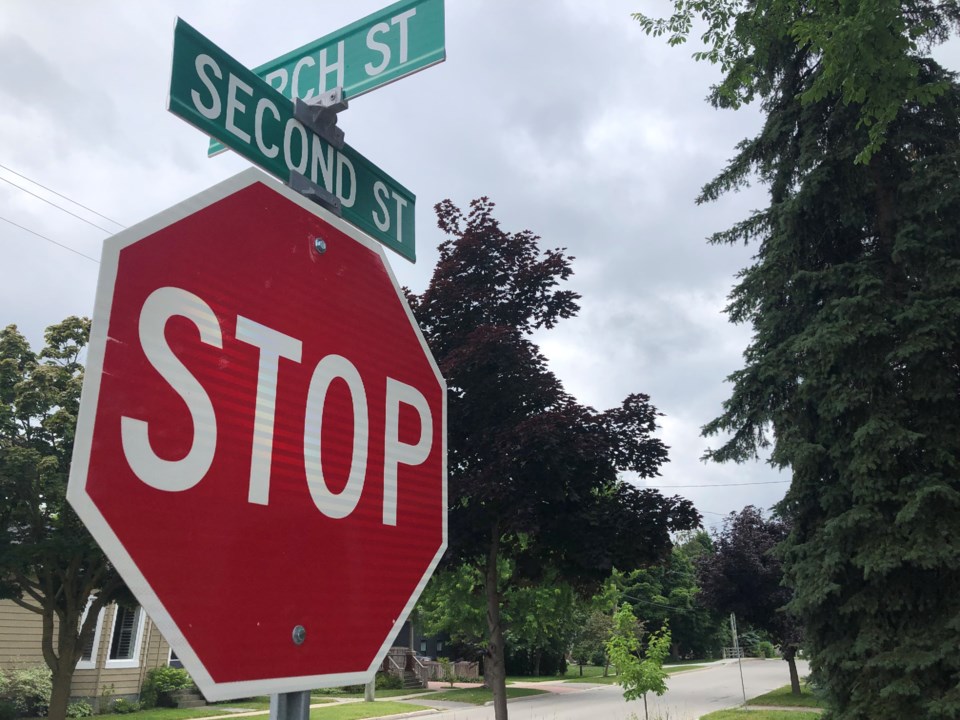One-way streets, no-turn streets and no-trucks-allowed streets could all be part of the future of Collingwood’s tree streets if a Second St. resident's group has their way.
John Housser, who lives on Second St. between Cedar St. and Oak St., provided a deputation to the development and operations standing committee on Monday night, proposing to reduce thru-traffic in “the tree neighbourhoods,” surrounded by First St. in the north, High St. in the west, Hurontario St. in the east and Sixth St. in the south.
The proposal was created after residents on Second St. were denied an application to the town to have traffic-calming measures installed on their street, despite a petition signed by 70 per cent of residents of the street asking for the change.
“Thru-traffic negatively impacts neighbourhoods. There is a low-cost solution,” said Housser. “The solution to traffic is not always traffic calming, because then all it does is push the problem to the next street. It’s more about neighbourhood solutions.”
“It’s more than just cars speeding on my street,” he said.
Back in June 2021, council passed a new traffic-calming policy to be followed by any resident who would like to request the town evaluate whether measures are needed in their neighbourhood.
According to the policy, the first step is for residents to submit a formal request with a petition including 51 per cent or more of those living on the street signing to support traffic-calming measures.
Despite 70 per cent of residents on Second St. signing the petition and traffic counts being done on the street, the request was denied as not enough cars were found to be speeding.
According to data from the Town of Collingwood, about 2,700 cars travelled Second St. per day in 2021.
When traffic counts were last taken in 2014, First St. saw about 27,833 vehicles per day. In 2016, Third St. saw about 3,326 vehicles per day, while Fifth St. saw about 2,298 vehicles per day.
According to overall estimations and calculations provided by Housser, he said about 63 per cent of vehicle traffic that runs through the area is thru-traffic, which is traffic not created by residents of the subject area.
“This traffic should be deflected to primary roads,” said Housser.
While Housser acknowledged that 19 four-way stops have been installed within the tree street neighbourhood to help calm traffic, he questioned why the town couldn’t go a step further by including signs that discourage thru-traffic altogether in certain areas such as do-not-enter, no-turns, one-way-only and not-a-thru-street signs for certain corridors.
“Drivers are like rats in a maze,” said Housser. “You need to change their behaviour.”
Housser pointed to phone apps such as Google Maps and Waze as contributing to the issue in Collingwood.
“Driving apps encourage cut-through traffic. If you use Waze to go from Canadian Tire to town hall, guess where it puts you? On Second Street,” said Housser. “Right now our streets are not safe as residential streets, and they should be. We believe there is an inexpensive solution to that.”
Coun. Deb Doherty said she hoped Housser would do the presentation again during public consultations for the draft Official Plan.
“It’s good to see how easy a solution can be,” said Coun. Yvonne Hamlin. “I fully agree with you that the problem is volume."
“I do think the Official Plan is the appropriate time for this to be addressed,” she said.
Director of Planning, Building and Economic Development Summer Valentine said she would also be forwarding Housser’s presentation to Planning Director Nathan Wukasch to be included in the public Official Plan comments for consideration.
The first draft of the Official Plan was presented to council on July 11, and is now open for public feedback. Community feedback and community information sessions on the draft plan are set for Aug. 2.
For more information on the draft Official Plan or to provide feedback to the town, click here.



